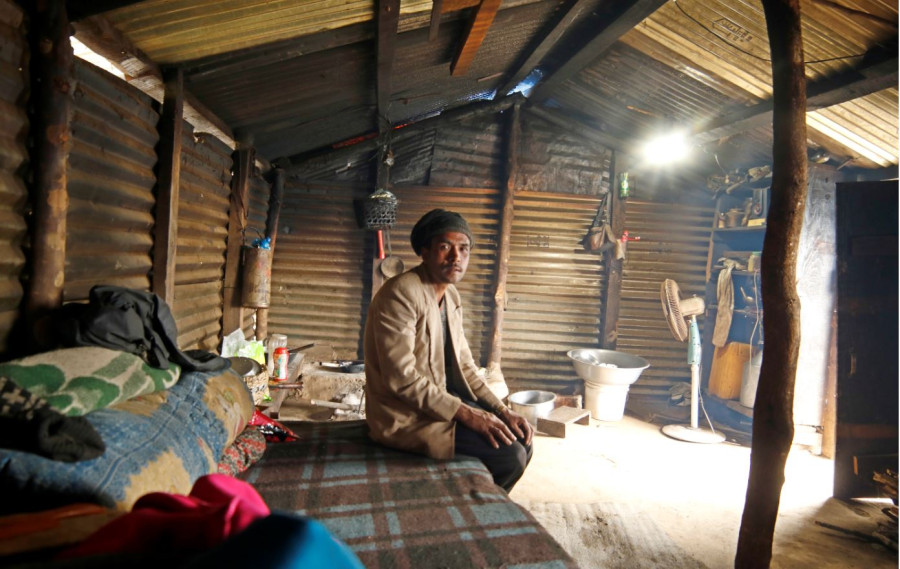National
Four years after Nepal’s deadly earthquakes, survivors continue to live in disarray
One of the biggest complaints from villagers is that the reconstruction grant is inadequate to initiate reconstruction and the overall tranche is not enough to complete a house.
By the time Maite Pasang Sherpa reached his house after the earthquake struck, it was already too late. He stood in front of his home, now collapsed to the ground. In front was the lifeless body of his eldest daughter, just nine years old. Inside the rubble of his home were two more bodies: his youngest daughter, who was five, and his aunt. Maite lost consciousness.
It has been four years since the deadly earthquakes ripped apart Listikot Ward 1, where Maite and his wife Pema have been living all their lives. Nearly 9,000 people from across the country lost their lives in the 7.8 magnitude earthquake on April 25, 2015, and the 7.3 magnitude aftershock on May 12—63 people were killed in Maite’s ward itself. Many villagers, like Maite in Listikot, are only just starting to pick themselves up from the devastation of that day—four long years later.
After living in a temporary shelter for three years, Maite and Pema finally began building a new house last year. But construction is far from over. A few days ago, Maite, who has already spent Rs 1.5 million, ran out of money to pay for building materials and labour wages, forcing him to stop construction. He had even sold some of his wife’s jewellery, and accrued nearly a million rupees in loans, which came with an interest rate of 24 percent.
“My family has already spent four years in a temporary shelter. I want to move them into the new house as soon as possible,” said Maite. “But I have no idea how to pay for the remaining construction, or how I can pay back the loans.”
Across villages in Sindhupalchok’s Listikot, one of the areas worst-hit by the earthquakes, stories like Maite’s are plentiful. Except for maybe 10 homes, all houses in the village collapsed or were severely damaged by the earthquake. Four years since, the village residents are still in disarray.
One of the biggest complaints from villagers is that the reconstruction grant is inadequate to initiate reconstruction and the overall tranche is not enough to complete a house. The government’s grant of Rs 300,000 was never meant to be enough to build a house—it was simply meant to assist victims begin reconstruction. But this has forced many in Listikot to take loans with high interest rates. Dozens of families in the villages are still living in temporary shelters while many are living where the government says there is a high risk of landslides.
According to a United Nations study, 50 percent of survivors of the 2015 earthquakes anticipate they need between Rs 400,000 to Rs 700,000 to finish housing reconstruction while 25 percent think they require between Rs 800,000 to Rs 1,200,000. As such, the government grant—which comes in three tranches of Rs 50,000, Rs 150,000 and Rs 100,000—is barely enough for survivors who don’t have savings or access to finance.
The grant process, many survivors say, is equally challenging as grantees must complete phase-wise construction to qualify for the second and third tranches. For those who don’t have the money to supplement the government grant and begin reconstruction, this poses a big problem. But authorities say a new loan scheme, introduced in November 2018, designed for earthquake survivors, will get things going.
“The government has now introduced a subsidised loan of Rs 300,000 for a five-year time period,” said Sushil Gyewali, CEO of the National Reconstruction Authority, the government body tasked with overseeing reconstruction work in the country.
Gyewali said that the loan is insured by the state with 5 percent of the interest paid for by the government, while the beneficiary is expected to pay the remaining 2 percent on the base rate of the banks. “This increases the safety level for private banks and they will not shy away like they have in the past,” he said.
According to the National Reconstruction Authority, 60 people have received a loan under the new scheme since November while 250 people have applied for it. Authorities say the new loan scheme will help survivors and provide them with much-needed financial access to rebuild their homes and the country will meet the reconstruction deadline of 2020.

(Left) Pempa Tamang’s house was completely destroyed by the earthquake and a few days later, several ropanis of her land were buried in a landslide. (Right) The 54-year-old has been living in this temporary shelter for the last four years. POST PHOTOS: Tsering Ngodup Lama
Long road to recovery
But if the state of reconstruction in Listikot is anything to go by, the government’s deadline appears far too ambitious. Here, it wasn’t just earthquakes that wreaked havoc four years ago—there were landslides, too.
“We saw several huge landslides, which sent a sludge of soil and boulders tumbling towards the villages. These landslides swept away huge tracts of agricultural land,” said Muke Sherpa, chairperson for Listikot Ward 1.
Across Listikot, otherwise green hills are scarred with landslides and boulders that look like they could tumble anytime. The scale of devastation was so severe that both the then prime minister and president visited the village. Both promised help.
But four years after the earthquake, recovery has been slow. Many villagers, like Maite, only began rebuilding homes last year while several dozens still live in temporary shelters. In remote villages here, the government-provided Rs 300,000 reconstruction grant has only gotten them so far.
Bahrabise, the nearest town from Listikot, is 29 kilometres from Listi, Listikot’s headquarters. The final 15km to Listi from Bahrabise is an uphill, bumpy, off-road track that is slippery, muddy and rocky. One mistake from a driver could send the vehicle plunging several hundred metres. The challenging terrain means higher transportation cost. To ferry 85 sacks of cement in a small truck from Bahrabise to Listi costs between Rs 11,000 and Rs 12,000. By the time a sack of cement that costs Rs 850 in Bahrabise reaches Listikot, it ends up costing nearly Rs 1,000. All raw materials required to build a house, from wall putty to iron rods, have to be transported from Bahrabise.
Not only is building a house in Listikot costly, it can only be done for seven months of the year. “Every monsoon, for nearly five months, the 15-km off-road track sees several landslides, making it impossible for vehicles to reach Listikot,” said Muke. “Many villages get cut off from the rest of the country.”
The indefinite closure of the nearby Tatopani border with China has only made things worse. The border has remained closed since April 2015, dealing a major financial blow to villagers, many of whom were employed as labourers, drivers and helpers by businesses in the border town. Some even had small shops there.
After the border closed, business dried up, rendering many from the village jobless. Many returned to the village, where the only work available is farming. But farming in Listikot has its own set of challenges. Even though the land is fertile and yields good quantities of potatoes, vegetables, and other grains, wild boar, deer, and porcupine wreak havoc on the fields and destroy crops. For most villagers, what they grow is barely enough to feed themselves.
The absence of a thriving cash economy, coupled with the region’s challenging terrain, has had direct impacts on reconstruction. “Nearly four years after the earthquake, more than 50 percent of families are still rebuilding or haven’t built houses,” said Muke.
Even at the national level, according to the Nepal Reconstruction Authority, as of April 2019, at least 50 percent of houses affected by the earthquake have yet to complete reconstruction. Officials at the Authority say the pace of reconstruction has been slow because of political events and economic realities.
“The promulgation of the constitution and both the local and national level elections diverted focus, time, energy and resources,” said Gyewali. The recent civil service adjustment bill also affected the transfer of engineers, and that directly affected reconstruction activities, he said. “Reconstruction has had to bear the brunt of all these parallel events and developments, but despite everything, we have made significant and satisfactory progress,” Gyewali said.
While the pace of reconstruction has picked up in all 32 districts affected by the quakes, loans remain a persistent challenge for most. The majority of those who have completed or have started reconstruction have taken loans with high interest rates from informal sources as they have little-to-no access to finance and subsidised loans.
The United Nations study, conducted in 17 affected districts, warns that the burden of debt could lead to a substantial impact on the overall economic recovery of affected communities for years to come.
The average rate of interest on loans, according to the Housing Recovery and Reconstruction Platform Nepal, is 23 percent and the non-payment of loan could incur loss of assets, including the family home.
After the earthquake, the international community and development partners pledged financial assistance amounting to $4.1 billion for post-earthquake reconstruction, recovery and rebuilding. According to the most recent Development Cooperation Report, about 88 percent has actually translated into actual commitments—$3.6 billion—and the government has been following up with donor partners.
However, as of July 2018, only $825.6 million had been disbursed. Officials told the Post that more money has come in since but that the details would be out only by the end of this fiscal year.

Maite Pasang Sherpa has taken nearly Rs 1 million in loan at 24 percent interest to build his house, which is still under construction.
Loans, loans, loans
Nearly an hour and a half’s walk from Maite’s house, past several landslide spots, is Listikot’s Sildhum Danda. There, on a wide flat ridge, are several temporary shelters, and homes under construction. The last temporary shelter on the ridge belongs to 45-year-old Thuli Lama, who moved there from Listikot’s Dalthali Tole after her house collapsed during the earthquake. A few days later, a huge landslide swept away five ropanis of her farm land. “I still remember the loud sound of rocks tumbling from the hilltop,” said Thuli. “It still gives me shivers.”
It was then that Thuli decided to move. After living in a temporary shelter for three years, braving heavy rainfall, hailstorms, lightning, and terrifyingly loud thunder, Thuli and her family started building a four-room house last year. The house, which is nearly complete, has already cost her family Rs 1.5 million. To foot the bill, the family has taken a nearly Rs 1 million loan from several sources at 24 percent interest, which is much higher than the average interest rate charged by commercial banks.
When the government rolled out its reconstruction grant of Rs 300,000 to those whose houses were destroyed by the earthquake, officials knew that the amount wouldn’t be enough. And to help people rebuild, the central bank in May 2015 directed commercial banks to issue concessional home loans for earthquake survivors, but the scheme died quickly.
The concessional loan scheme of Rs 2.5 million for Kathmandu Valley victims and Rs 1.5 million for those outside the Valley—at an annual interest rate of 2 percent—was discontinued last year after only 1,500 people accessed the loan, mostly within the Valley, as banks were hesitant to offer loans against rural land as collateral.

Thuli Lama has taken nearly Rs 1 million loan at 24 percent interest to build her four-room house after living in a temporary shelter for three years.
“It’s not that we didn’t try applying for loans from banks. But banks seek collateral, and all we had to offer were our village lands, which the banks are not interested in,” said Thuli. “So, we have no option but to look for informal sources to get loans, even if they come with high interest rates.”
A few metres behind Thuli’s house, the flat ridge slopes. On the slope is a settlement of 10 temporary shelters, all belonging to Dalit families from Lathi Bang village, about 500 metres down the hill.
Sukhbir BK and his family have been living in the settlement since the earthquakes. At the entrance of their one-room shelter is a woodfire earthen stove, and every time food is cooked, smoke fills the room. Six months before the earthquake, Sukhbir had built a house with the money his wife had saved from the four years she spent working in Lebanon. “The house cost us one million rupees to build, and the earthquake destroyed it in a matter of minutes,” said Sukhbir.
A year ago, Sukhbir started building a two-room home, now close to being done. He has spent Rs 500,000 for construction, and taken a loan of Rs 100,000 at an interest rate of 36 percent. “I did all the masonry work myself. My younger brother, a carpenter, did all the carpentry work,” said Sukhbir. “The cost would have been much higher otherwise, and I would have had to take more loans.”
Today, a majority of families in the villages of Listkot are buried in loans they have been forced to take to complete the construction of their new homes. “Right now, there is construction work in the village, which has helped people pay their interest,” said Lama Peng Gyalsang, chairman of the Jyangter Shedupling Pawo Monastery in Pawo Gumba village. “But construction won’t go forever. What then?”
Many villagers who once worked at the Tatopani border are waiting and watching, as the border is slated to reopen next month. But not everyone is optimistic. “All my life, I ran a restaurant in the border town, and that’s the only work I know,” said Thuli. “Once the border reopens, I’ll head back and continue doing what I did, and start paying back the loans.”
Thuli also has a backup plan. “If the border doesn’t open soon, I’ll head to the border in Kerung to work. I’ll open a restaurant there,” she said. “I am too old to go abroad. I don’t have the money to pay the agents, nor do I have the education to be able to work there.”
Relocation limbo
The village of Pawo Gumba is a 20-minute walk from Listi. More than 63 families live in the area, which the government has said is at high risk of landslides and has advised them to relocate.
“But the government hasn’t informed any of the families how, when, and where they’ll be relocated,” said Lama Peng Gyalsang. “In the last two years, we haven’t seen major landslides, and people have started rebuilding their homes.” Adding to the confusion, Gyalsang said the government has also provided reconstruction grants to those families, contradicting itself.
Nearly 80 percent of families in Pawo Gumba have already built new homes or are close to building one. Whether the villagers will agree to relocate now hinges on two factors: where will they be moved and how much land they will be provided.
“Villagers here own several ropanis of land,” said Muke. “They need a lot of land because they have to farm, build a house, and have enough land to graze their livestock.”
According to a study conducted by the National Reconstruction Authority to identify vulnerable settlements after the earthquake, 2,752 families from 112 communities in earthquake-affected districts have to be relocated to safer places. As of April, the official number has gone up to 4,469 families. So far, only 1,652 families have opted to receive the Rs 200,000 grant the government provides to buy new land to families living in vulnerable settlements. But 628 families have availed of land directly from the government.
While data shows that the trend to apply for the grant to buy land is higher, the grievances of the remaining 2,189 families have yet to be addressed, as most of them do not want to move from their native settlements. But as the National Reconstruction Authority intends to sign agreements within this fiscal year—by the end of May—officials expect fierce opposition from villagers. But they won’t bow to any kind of pressure, says Gyewali.
“If there are possibilities where mitigation efforts can be proven to reduce disaster risks, we will focus on mitigation measures instead of resettlement, but the cost of mitigation cannot be higher than the cost of resettlement,” said Gyewali. “We just dismissed the resettlement of survivors from Rasuwa in Khalte despite the social and political pressure because the Trishuli riverbank has been identified as hazardous by geologists. People will be the first priority, not relocation.”
Permanently in temporary shelters
The earthquake completely destroyed 54-year-old Penpa Tamang’s house in Pawo Gumba. A few days after the earthquake, a landslide buried several ropanis of her farmland. Penpa has since been living alone in a crammed one-room temporary shelter.
Brass utensils that once belonged to her parents are strewn everywhere inside the shelter and the only wooden furniture is a low wooden bed. Lighting up the shelter is a dim solar-powered bulb, which she received as aid.
The shelter’s wall and roof are made of tin sheets, many of which have already rusted. A tarpaulin sheet covers only one half of the roof, and every time it rains, water leaks from the holes in the other half of the roof. Droplets of rain enter from the gaps between the shelter’s roof and walls.
“I don’t have the money to build a house. This might probably be it for me,” said Penpa.
About a kilometre from Penpa’s shelter is a spot where Hothemaili Lama’s house used to stand. Today, there is just a pile of stones overgrown with plants and creepers. When the earthquake struck, her home collapsed like a house of cards.
When Hothemaili applied for the Rs 300,000 reconstruction grant, she learned that somebody had informed the government authorities based in Chautara, the district headquarters of Sindhupalchok, that she owned another house in the Tatopani border area.
“Hothemaili ran a tea shop in a tiny shed built on public land in Tatopani. She didn’t own a house there. We don’t know who spread this wrong information,” said Nurbu Sherpa, a resident of Listi. To make her case, Hothemaili has already visited government officials in Chautara three times. Each trip cost her Rs 10,000 on accommodation, food and transportation. “We are trying our best to sort out Hothemaili’s case and are in touch with district officials,” said Muke.
There are nearly 100 such families in Listikot Ward 1 who, despite having their houses destroyed by the earthquake, have been excluded from the reconstruction grant recipient list. “Our focus now is to speed up the process so that these families can receive the grant as soon as possible,” said Muke.
As of April, the Reconstruction Authority has registered 436,662 cases of grievances from all over Nepal, regarding housing reconstruction, and in the process, identified 88,367 new beneficiaries who are qualified for the reconstruction grant and 44,369 beneficiaries for the retrofitting grant. Grievances include those who have not been able to start reconstruction due to issues of geological vulnerabilities in the aftermath of the quake.
“Some communities want to retain traditional architecture and settlements, some want more aid, while others are waiting for land reallocation and have opted for integrated settlements,” said Gyewali. “And there are landless people, too.”
***

Maite with his family in their temporary shelter. He lost two of his daughters to the earthquake that devastated Listikot in Bhotekoshi, Sindhupalchok.
In the bedroom of Maite and Pema Sherpa’s temporary shelter, there are several pictures of their two deceased daughters. Maite’s eyes well up with tears as he counts how old his two daughters would have been had they been alive. Sleeping on one of the beds is their five-month-old son.
“It’s definitely not going to be easy to recover from all that has happened. I don’t know if we will ever regain a sense of normalcy,” said Maite.
For many villagers like Maite, their options are running out. Soon, many of the village’s youngsters may have no alternative but to find work in the Gulf or in Malaysia.
Maite said he might have to leave the country to find work that pays well.
If he does, it will be his third time—he worked in Malaysia from 2010 to 2015, and then in Saudi Arabia for two years, from 2015 to 2017.
But going abroad comes with its own set of problems. To find work in the Gulf, villagers have to pay manpower agents, for which they’ll have to take more loans. When Maite’s wife went to Iraq in 2013, the family had to take a loan of Rs 50,000 to pay the recruiting agent.
“It’s not easy being away from family for so long,” Maite said. “But I don’t see any other option for me.”




 8.12°C Kathmandu
8.12°C Kathmandu














